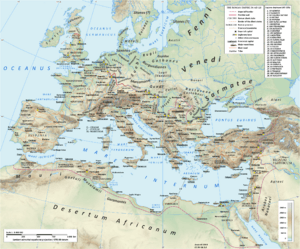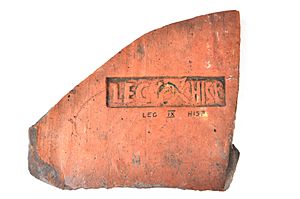Legio IX Hispana facts for kids
Quick facts for kids Legio IX Hispana |
|
|---|---|

|
|
| Active | Before 58 BC to sometime in the 2nd century AD |
| Country | Roman Republic and Roman Empire |
| Type | Roman legion (Marian) |
| Role | Infantry assault |
| Size | c. 5,400 |
| Garrison/HQ | Hispania Tarraconensis 41–c. 13 BC ? Pannonia 9–43 AD Eboracum (Britannia) 71–c. 121 ? Noviomagus (Germania Inferior) c. 121–130 |
| Nickname(s) | The Lost Legion |
| Mascot(s) | Bull |
| Engagements |
|
| Commanders | |
| Notable commanders |
|
The Legio IX Hispana, also known as the "9th Spanish Legion," was a famous Roman legion. A legion was a large unit of the Imperial Roman army, like a big army division today. This legion existed for a long time, from the 1st century BC until at least 120 AD.
The Ninth Legion fought in many parts of the Roman world. It got its nickname "Hispana" because it was stationed in Hispania (modern-day Spain) for a while. Later, it was sent to Roman Britain after the Romans invaded in 43 AD.
The most mysterious thing about the Ninth Legion is that it simply disappears from Roman records after about 120 AD. No one knows exactly what happened to it, which is why it's often called "The Lost Legion." This mystery has led to lots of research and exciting stories!
Contents
The Mystery of the Lost Legion
The unknown fate of the Ninth Legion has puzzled historians for a long time. Many people have wondered what happened to these brave Roman soldiers.
Early Theories: Lost in Britain?
One popular idea, suggested by historian Theodor Mommsen, was that the legion was wiped out in northern Britain. This might have happened around 108 AD, during a rebellion by local tribes against Roman rule. This theory became very famous because of a 1954 novel called The Eagle of the Ninth. In the book, the legion marches into Caledonia (which is modern-day Scotland) and is never seen again.
New Clues: Where Did They Go?
However, modern historians started to doubt this theory. Why? Because new clues were found! Several Roman inscriptions from the Ninth Legion were discovered in Nijmegen, a city in the Netherlands. This suggested that the Ninth Legion might have been based there around 120 AD, which is later than when they were supposedly destroyed in Britain.
These new findings led to different ideas about the legion's end. Some historians now think the Ninth Hispana might have been destroyed in later wars during the 2nd century. For example, they might have been lost during the Bar Kokhba revolt (132–135 AD) in Judea, or during Emperor Marcus Aurelius's war against Parthia (161–166 AD) in Armenia.
But some experts still believe the Nijmegen evidence only shows a small part of the Ninth Legion was there, not the whole army. So, the mystery continues! What is clear is that the Ninth Hispana was definitely gone by the time Emperor Septimius Severus ruled (193–211 AD). It's not on any official lists of legions from that time.
The Legion's Early History
The exact beginning of the Ninth Legion is a bit unclear. But it seems a 9th legion was involved in a battle called the siege of Asculum around 90 BC, during a war in Italy.
Serving Under Julius Caesar
When Julius Caesar became governor of Gaul (modern-day France) in 58 BC, he already had four legions, including the Ninth. The Ninth Legion might have been stationed in a city called Aquileia to protect against attacks. Caesar used the Ninth and other legions in his famous Gallic Wars.
The Ninth Legion also fought in important battles for Caesar, like Dyrrhachium and Pharsalus. After Caesar won, he disbanded the legion, and its veteran soldiers were given land to settle down.
Reforming for Augustus
After Caesar was killed, the Ninth Legion was brought back to fight again. They helped Augustus (who later became the first Roman Emperor) in his wars, including the famous Battle of Actium in 31 BC.
The Imperial Roman Army
Once Augustus became the sole ruler of the Roman world, the Ninth Legion was sent to Hispania. They took part in a big war against the Cantabrians (25–19 BC). This is likely when they earned their nickname "Hispana," meaning "Spanish."
After that, the legion probably moved to the Rhine river border, fighting against Germanic tribes. After a terrible Roman defeat in Germany in 9 AD, the Ninth Legion was moved to Pannonia (a Roman province in Central Europe).
The Ninth Legion in Britain

In 43 AD, the Ninth Legion most likely took part in the Roman invasion of Britain. They quickly became part of the Roman army stationed there. Around 50 AD, the Ninth helped defeat the forces of a British leader named Caratacus. They also built a fort at what is now Lincoln, England.
The Ninth Legion faced a huge challenge during the rebellion led by Queen Boudica in 61 AD. They suffered a terrible defeat near Colchester, where most of their foot soldiers were killed. Only the cavalry managed to escape. The legion had to be reinforced with new soldiers from other Roman provinces.
Later, around 71–72 AD, the Ninth Legion helped put down another rebellion in northern Britain. Around this time, they built a new fortress at York, which was called Eboracum by the Romans.
The Ninth Legion also joined Gnaeus Julius Agricola's invasion of Caledonia (Scotland) in 82–83 AD. They almost faced disaster when Caledonian warriors launched a surprise night attack on their fort. The Caledonians burst into the camp, but Agricola sent cavalry to help, and the Ninth Legion fought back bravely. They also took part in the decisive Battle of Mons Graupius.
The last clear record of the Ninth Legion in Britain is from 108 AD. This was when they rebuilt their fortress at York using stone. This is known from an inscribed stone tablet found in 1864, which you can see today in the Yorkshire Museum.
The Ninth Legion in Germania Inferior

After 108 AD, several clues suggest that parts of the Ninth Hispana were present at a Roman fortress in Nijmegen, in what was then called Germania Inferior (modern-day Netherlands). These clues include stamped tiles and a military medal with "LEG HISP IX" written on it. An altar dedicated to the god Apollo was also found nearby, set up by a high-ranking officer of the Ninth Legion.
This evidence suggests that at least some of the Ninth Legion was in Nijmegen sometime after 104 AD. It seems they were replaced by another legion around 120 AD. It's still debated whether the entire Ninth Legion was there or just a smaller group of soldiers.
More Theories About the Ninth's Disappearance
The Nijmegen discoveries, dating to around 120 AD, are the latest clear records of the Ninth Legion. We know for sure the Ninth was gone by 197 AD, because it's not on any official lists of Roman legions from that time. So, the Ninth Hispana disappeared sometime between 120 and 197 AD.
Lost in Britain (Again)?
Some scholars still argue that the Ninth was most likely destroyed in Britain. They believe it happened in the late 110s or early 120s, when the province was in chaos. They point to Roman historian Marcus Cornelius Fronto, who wrote that many Roman soldiers were killed by Britons during Emperor Hadrian's time (117–138 AD). Hadrian himself visited Britain around 122 AD and ordered the building of Hadrian's Wall, possibly in response to a military disaster. However, there's no clear archaeological evidence of such a disaster around 120 AD.
Lost in the East?
Other historians suggest the Ninth Legion might have been destroyed in later conflicts in other parts of the Roman Empire:
- The Second Jewish Revolt (132 AD): This revolt in Judea caused heavy Roman casualties. The Ninth might have been sent there to help, but was defeated.
- War Against Parthia (161 AD): A Roman historian, Cassius Dio, wrote that a Roman legion was wiped out by the Parthians in Armenia. While two other legions were usually stationed there, they are known to have existed much later. So, some wonder if it was the Ninth. However, there's no evidence the Ninth was in the East between 130 and 160 AD.
The debate about the Ninth Legion's fate continues among historians. As one scholar noted in 1967, "further evidence is needed before more can be said."
The Ninth Legion in Stories and Movies

The mysterious disappearance of the Ninth Legion has made it a very popular topic in books, movies, and TV shows!
- In Rosemary Sutcliff's 1954 novel The Eagle of the Ninth, a young Roman officer searches for his father's lost legionary eagle beyond Hadrian's Wall. This book was also made into a BBC television drama in 1977 and a movie called The Eagle in 2011.
- The 2010 movie Centurion also tells a story about the Ninth Legion's fate.
- In the 2017 Doctor Who episode "The Eaters of Light", the remnants of the Ninth Legion are featured, wiped out by an alien creature.
- The 2019 movie Horrible Histories: The Movie - Rotten Romans includes the Ninth Legion, nicknamed "The IX Men."
- Many other books and stories imagine what happened to the Ninth Legion, from being transported to other planets to fighting mythical creatures!
Images for kids
-
The last definite attestation of the Ninth: a stone inscription at York dated 108, on display in the Yorkshire Museum in York.
See also
 In Spanish: Legio IX Hispana para niños
In Spanish: Legio IX Hispana para niños
- List of Roman legions
- Castra
- Limes (Roman Empire)
- Structural history of the Roman military
- Silchester eagle


